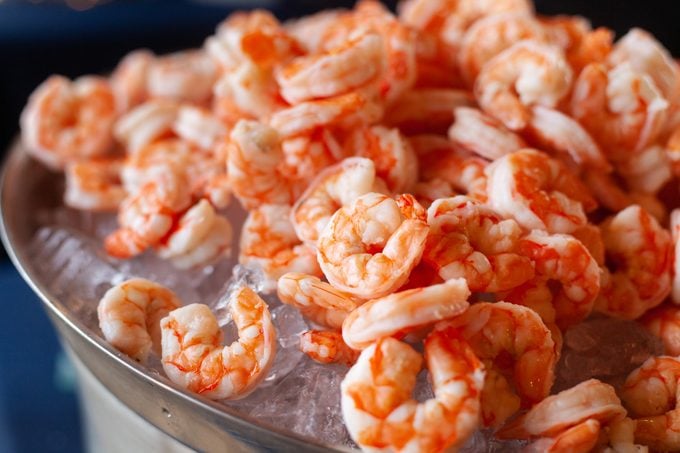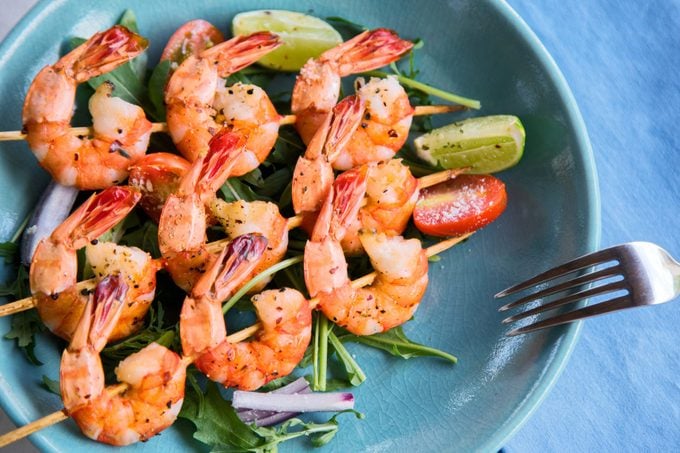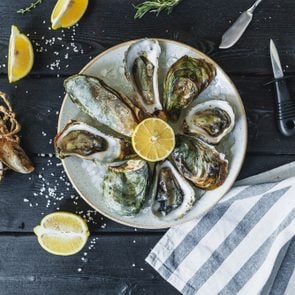6 Health Benefits of Shrimp
Updated: Mar. 08, 2022
Ready to learn all the great shrimp benefits? Dietitians dive in on everything about this crustacean.
Shrimp benefits to know
Shrimp is one of the most popular seafoods out there. It appears in a variety of dishes, from shrimp scampi to shrimp and grits. And what makes diving into a shrimp dish even more exciting: all the healthy shrimp benefits this seafood can offer. Let’s take a look at them.
A good source of protein
Per 3 ounces of cooked shrimp, you get an amazing 20 grams of protein—which is 40 percent of the recommended daily value (DV). Plus, this is for only 84 calories. The protein in shrimp can help keep you fuller for longer, which is important for weight management and fueling exercise.
A source of beneficial minerals
Many of the health benefits of shrimp boil down to the nutrients it contains.
“Shrimp is a versatile, low-calorie seafood that provides iodine, phosphorus, zinc, and magnesium,” says registered dietitian Lisa Andrews, MEd, owner of Sound Bites Nutrition in Cincinnati, Ohio. These minerals are important for many reasons.
For instance, zinc is beneficial for immunity, and magnesium is helpful for everything from bone health to blood pressure.
Heart health benefits
Plus, shrimp provides anti-inflammatory eicosapentaenoic acid (EPA) and docosahexaenoic acid (DHA), both of which are omega-3 fatty acids. Increasing your intake of these omega-3s can significantly help reduce heart disease risk, according to research in Mayo Clinic Proceedings.
Another study in Mayo Clinic Proceedings notes that shrimp intake was favorably associated with improved lipid panels, says registered dietitian nutritionist Aubrey Redd, owner of Aubrey Redd Nutrition in King of Prussia, Pennsylvania.
The study authors say eating shrimp is connected with a lower risk of heart disease than in people who do not eat shrimp.
May boost cognitive health
Another one of the top shrimp benefits? The seafood boasts astaxanthin, an antioxidant that can help protect against free radical damage.
“This might help lower risk of cardiovascular and neurodegenerative diseases, such as Alzheimer’s and Parkinson’s,” says registered dietitian Anya Rosen in New York.
“Anti-inflammatory properties of astaxanthin have also been shown to help with diabetes, gastrointestinal, renal, and skin and eye diseases.” That’s a lot of disease-fighting potential all in one food.
Helpful for pregnancy
Eating seafood during pregnancy can be especially beneficial for unborn children. “Seafood has been found to be beneficial during pregnancy for the neurocognitive development of infants,” Andrews says. “This occurs with as little as 4 ounces per week.”
And good news: Shrimp is in the “best choices” category of seafood for women who are trying to get pregnant, are pregnant, or are breastfeeding—as well as young children—in the U.S. Food and Drug Administration’s “Advice About Fish” guide.
Good for thyroid disease
One more surprising benefit that shrimp offers: “It’s a healthy food for individuals with thyroid disease, as it provides iodine and selenium, two minerals needed for normal thyroid function,” Andrews says.
Both iodine and selenium are essential minerals, as they’re necessary for optimal development and function, according to the National Center for Complementary and Integrative Health.

Shrimp nutrition facts
Are you wondering about seafood nutrition? Here are the nutrition facts—including the DVs—for a 3-ounce serving of cooked shrimp.
- Calories: 84
- Total fat: 0 g (0 percent DV)
- Protein: 20 g (40 percent DV)
- Carbs: 0 g (0 percent DV)
- Sodium: 94 g (5 percent DV)
How shrimp can be bad for you
As with any food, steaming or grilling will be a much healthier cooking method than deep frying—and allows you to control both the calories and fat content of a dish.
You also need to take into account shrimp’s methylmercury content. You can use online tools to choose shrimp with lower mercury content. The Environmental Defense Fund (EDF) has a helpful seafood selector for choosing lower-mercury seafood.
Because shrimp are small, they’re lower on the food chain than larger seafood.
“As the size of the fish goes up, the recommendation for weekly consumption goes down,” Redd says.
“Why, you ask? Fish higher in the food chain are more likely to contain dangerously elevated levels of mercury. This is especially of concern for mothers who are expecting, as excess mercury can cause damage to the fetal nervous system.”
Rosen notes that if you’re pregnant or breastfeeding, you should stick to two weekly servings of shrimp, max.
Shrimp also contains cholesterol: 161 milligrams of cholesterol (54 percent DV) per 3-ounce portion.
“The current recommendation is to keep dietary cholesterol to less than 300 milligrams daily and as low as possible,” says registered dietitian nutritionist Joan Salge Blake, a nutrition professor at Boston University and host of the nutrition and health podcast, “Spot On!”
“Thus, you need to balance this intake with the rest of your diet.”
While you should pay attention to dietary cholesterol, current research suggests saturated fat has a bigger impact on the body’s cholesterol levels than dietary cholesterol.
In fact, the American Heart Association says limiting foods high in saturated and trans fats is more key to controlling cholesterol levels in the body.
Also, know that shrimp is a top allergen, along with milk, eggs, fish, tree nuts, peanuts, wheat, and soybeans. This means people who are allergic might experience severe and even life-threatening anaphylaxis when eating shrimp. So if you’re allergic, carry an EpiPen in case of emergency.

How much shrimp to eat
The answer, as with many things, isn’t super straightforward. While the 2020-2025 Dietary Guidelines for Americans advise adults to aim for two 4-ounce servings of seafood per week, other experts suggest eating up to three 4-ounce servings of seafood per week.
How to eat shrimp
There are an endless number of ways to eat shrimp.
“Shrimp is a very versatile protein source and can be boiled, broiled, sautéed, steamed, stir-fried, grilled, or baked,” Andrews says. “To keep it low-fat, avoid adding heavy cream sauces.”
And food safety is key when it comes to preparation.
“The most important consideration when cooking shrimp is to ensure that it meets the minimum safe internal temperature of 145 degrees Fahrenheit,” Redd says.
“A good rule of thumb to identify if it needs more time is to check the color. Shrimp start to turn pink as they’re done cooking, and their flesh protrudes outward. Be sure to keep an eye on them though, because they cook quickly!”
Shrimp recipes to try
Try these nutritiously delicious shrimp recipes from registered dietitians:
- 66 Juicy Shrimp Recipes
- Grilled shrimp tacos from Kelsey Sackmann, RD
- Simple shrimp and grits from Andrews
- Shrimp scapi spaghetti squash bowls from Jenny Shea Rawn, RD
- Mojito shrimp from Judy Barbe, RD
- Honey orange shrimp stir-fry from Megan Byrd, RD
Now that you know about these shrimp benefits, check out these other healthy fish recipes.






















